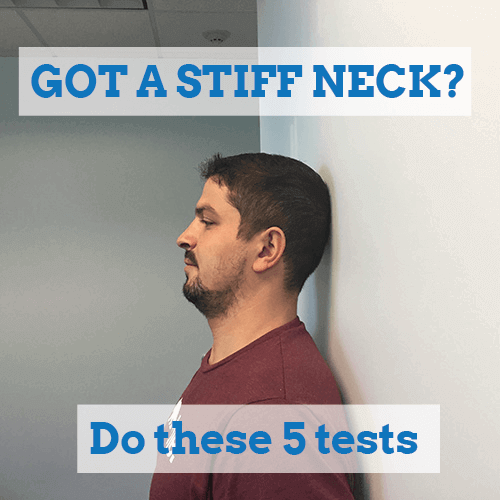
25 Sep Got a Stiff Neck? Do These Tests.
Stiff necks tend to get stiffer over time.
Sure, massages give you relief, but you stiffen up again after 2-3 days.
Heck, you feel amazing after getting adjusted! But samesies, it doesn’t last (I call this the Irrelevant Pain Relief Window) and you have to keep going back to the chiropractor to not feel anything.
It’s frustrating that no matter what you do, the trend is towards more and more stiffness over time.
The reason for this trend is that something is missing.
It’s a really big problem and almost no one is talking about it in healthcare today. Continue reading and you’ll see 5 tests you can use to find out if this big problem exists in your neck!
Why Am I Getting Stiffer Even Though I’m Getting More Adjustments and Massages?
Insanity is doing the same thing over and over and expecting a different result. ~Albert Einstein
Effective treatment for your stiff neck and pain would give you more permanent relief than 48-72 pain-free hours.
Understand that truth and realize, what you’re doing isn’t working.
And doing more of it won’t give you a different result.
So stop the insanity, please.
You’re getting stiffer in your neck because your problem(s) is(are) getting bigger.
Stiffness is not a magical problem that just occurs out of thin air.
No, you don’t need to do more stretching. Chances are, you’ve been stretching and the stiffness is still growing. Hence, my proof for you to stop stretching.
The key to getting rid of the stiffness is identifying the problem.
5 Tests to Determine If Your Head is Going to Fall Off Your Neck
When a person with a stiff neck, neck pain, or numbness/tingling down their arms or hands comes into our office at Barefoot Rehab, there are 5 tests we always perform to help us determine if your head is going to fall off your neck.
I’m playing with you, your head isn’t going to fall off.
But, your neck may be in trouble. Just how much trouble, we do not know, yet.
The 5 tests are checking different muscles from the back of the skull down to your mid-back (where your wing bones are).
In the office, we measure the following:
- Range of Motion
- Effort
- Symptom Location, Quality, and Severity
The only thing I want you to pay attention to is:
- Quality, and Severity
Here’s what you should expect to feel:
What does Quality mean?
If you have “tingling” or “numbness” anywhere in your neck, upper back, or down your arms, you have a nerve problem.
If you have “pinching”, you have a disc or arthritis problem.
If you have “sharpness”, you have a “more severe ” problem.
If you have “tightness” that increases as you finish the motion, you have an adhesion problem.
What does Severity mean?
Severity is pretty straight-forward.
- Mild = a small problem.
- Moderate = a medium problem.
- Severe = a serious problem.
Now, let’s get on to the tests …
Do These Tests to Determine The Severity of Your Stiff Neck
The chin tuck test is checking the muscles right underneath the back of your skull.
This is a great test to determine if your “headaches” are coming from your neck or if they’re not musculoskeletal. HINT: If this test increases your headache or neck pain, then you have a “tension headache” and can be helped by a musculoskeletal provider.
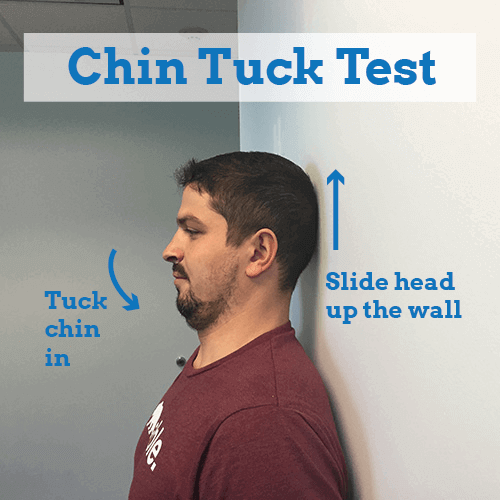
Stand with your feet, butt and head against a wall.
Slide the back of your head up the wall as you tuck your chin in, creating a “double chin”.
What is the quality and severity of what you feel?
The Chin to Chest Test checks all of the muscles and joints in your neck (excluding your upper back).
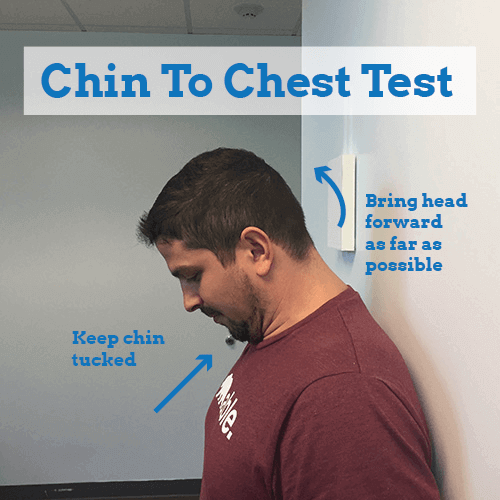
To perform this test, keep your chin tucked, then bring your head as far forward as possible.
What is the quality and severity of what you feel?
Make sure that you do not let your chin relax. You may get a “false negative”, meaning that this test should be a fail, but you think you’re passing it because you’re doing it wrong.
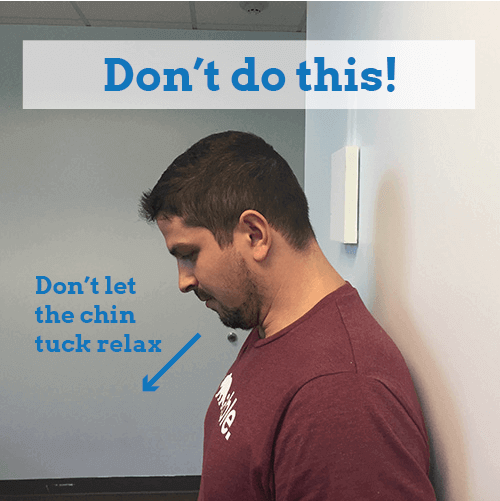
The CT Flexion Test combines the neck (C) and upper back (T) areas of your body.
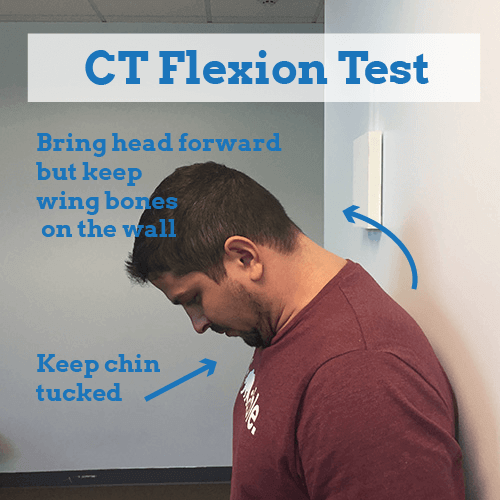
Keep your chin tucked, bring your head forward as far as you can without your wing bones coming off the wall.
What is the quality and severity of what you feel?
The Rotation Test checks the small, tiny muscles that are really deep in your neck. It will often also bring out moderate-to-severe arthritis moreso than the other tests. You would feel “pinching”.
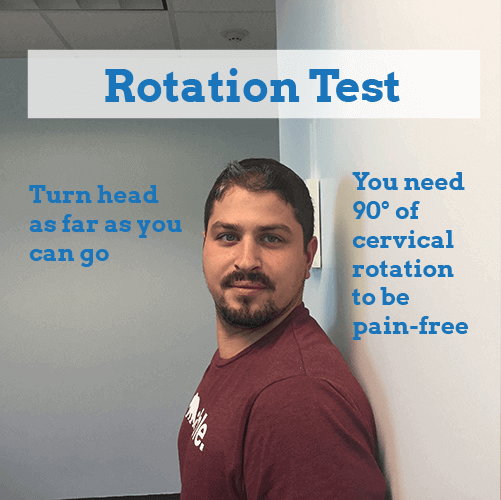
Turn your head as far as you can go.
Most people know they have rotation issues because one of the most common complaints in our office is:
I can’t see out of my blind spot when I’m driving.
Make sure that when you turn your head, you don’t cheat and bend your head to the side. This is a compensation for a lower neck problem.
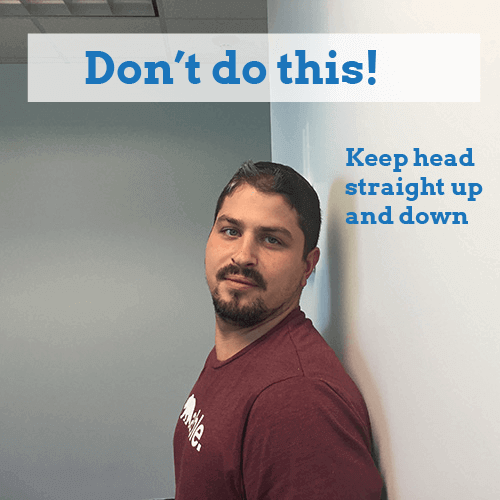
If you cheat, you might even look as sad as our model Kyle did in the above picture.
How A Doctor Measures These Tests
In the office, we measure these tests using glasses and a level to determine ranges of motion.
To have a normal, healthy, pain-free neck that will degenerate as little as possible as time goes by, you need the following ranges of motion:
- Chin Tuck Test – 25 degrees, symptom-free, easy
- Chin to Chest Test – 60 degrees, symptom-free, easy
- CT FLexion – 90 degrees, symptom-free, easy
- Rotation (to left and right) – 90 degrees, symptom-free, easy
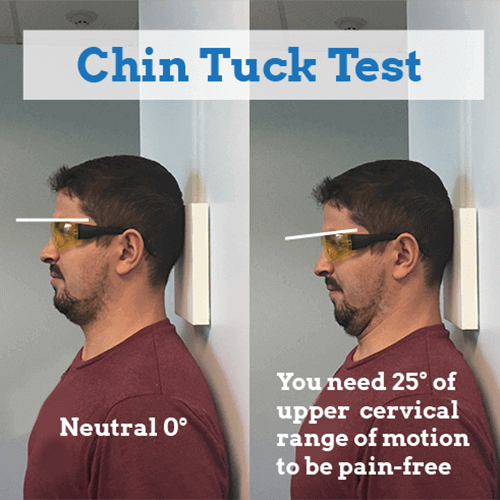
This is with the chin tucked in.
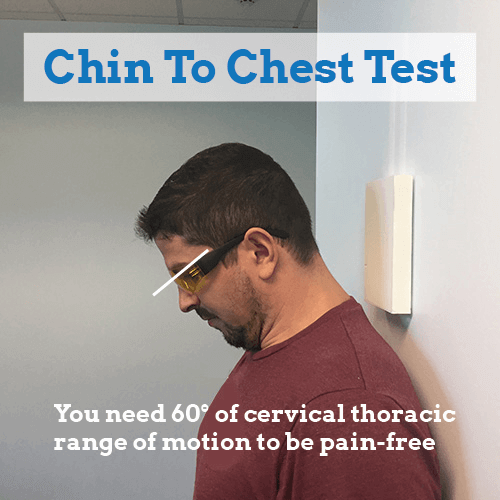
This is with the chin tucked in and the head tilted forward.
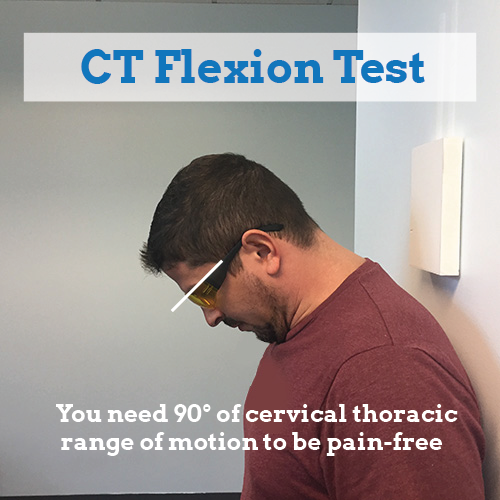
This is with the chin tucked, head forward, and wing bones still on the wall.
Notice, Kyle’s line is far from 90 degrees. This is because his neck is not healthy. In an ideal world, this line would be going straight up and down, perpendicular from the floor.
How Stiff Are You? Work On Your Stiffness or Get Help!
At this point, hopefully you feel empowered that:
- if you felt mild stiffness in a bunch of tests, you don’t have a huge problem to worry about.
- if you felt severe stiffness (or some other sensation) in the tests, then you should start to think about doing something about it. If the stiffness increased gradually towards your end range, then you have a little-big problem called adhesion.
You can try stretching for a month, then re-check the tests.
You could even try massages, remember to re-check the tests.
Do you like getting your neck adjusted? REMEMBER to re-check the tests. If you don’t recheck the tests, you could end up like my mom, getting adjusted all your life with ever-increasing stiffness in your neck.
Effective treatment that gets rid of your problems will make your stiffness better in less than 5 treatments (honestly, it’ll happen in 1-2 treatments most of the time).
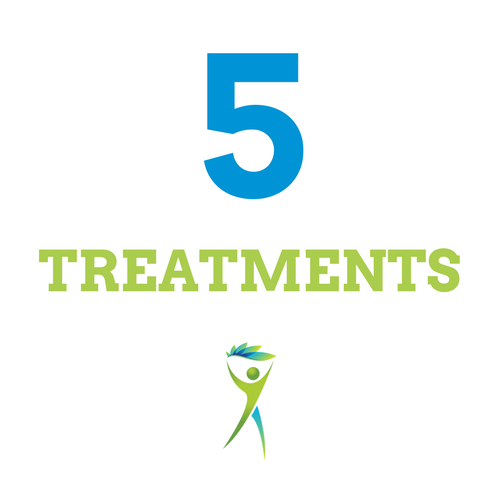
If you want to reduce your stiff neck in as little as 1-5 treatments, then consider finding an Integrative Diagnosis Provider. Or if you live in Northern New Jersey, call us at Barefoot Rehab.
 How severe is your stiff neck? Did you feel anything that felt weird? Or was in a weird place? Feel free to share and I’ll help you understand what you felt.
How severe is your stiff neck? Did you feel anything that felt weird? Or was in a weird place? Feel free to share and I’ll help you understand what you felt.

10 Lessons I've Learned in 10 Years of Chiropractic Practice
Posted at 14:11h, 30 December[…] Do you pass these 5 neck tests? […]
NICK STELLAS
Posted at 09:53h, 09 MarchWHAT DO YOU MEAN BY “PINCHING”?
Dr. Chris
Posted at 13:18h, 09 MarchPeople describe a “pinch” this is what it would feel like. Does it feel like a different sensation?
Justin Allen
Posted at 22:19h, 11 NovemberI have these little spots on my back that hurt to touch.. Any idea what it might be? it seems like I have them on both sides. My back has been killing me.
Dr. Chris
Posted at 00:43h, 17 NovemberThose spots can be:
– Adhesion
– Trigger points
– Nerve entrapments
– Referred pain from another spot
You’d need to give WAY more information for me to have any idea.
Bottom line – something is overloaded and your body is telling you with those spots. As always, the earlier you fix them, the more permanent relief you’ll get. Best not to wait til you get older.
Merrin Maria Jose
Posted at 15:43h, 26 Marchcan u tell how to correct neck hump? i have a tiny bump and i developed it because of online classes. and i am 17 yrs old, its really bothering me too. and it gets worse when i wake up from my sleep and all my joints feel stiff too. Also is it common to feel C-7 bone when i run my hand down my neck? I keep asking my friends if they also feel the same and they say yes they do and i am crazy lol. Also i am not able to maintain my correct posture for a long time, and once i am not thinking about my posture, it comes back to bad posture. Should our body be in good posture even if we are not thinking about it? Thankyou.
Dr. Chris
Posted at 12:25h, 07 AprilHi Merrin, YES, it is common for almost all people to feel C7. To fix a neck hump, posture, or weakness, it’s a combination of removing adhesion in the muscle so they can work properly and then strengthening with physical therapy. Yes, your body should be in good posture without thinking about it, but you need to ear that right.
Lily Portman
Posted at 21:09h, 13 SeptemberWhere should I massage my neck when I have neck pain?
Dr. Chris
Posted at 11:42h, 26 SeptemberWe deal with people who have chronic neck pain. If I told you where to massage it, I would be guessing and failing you.